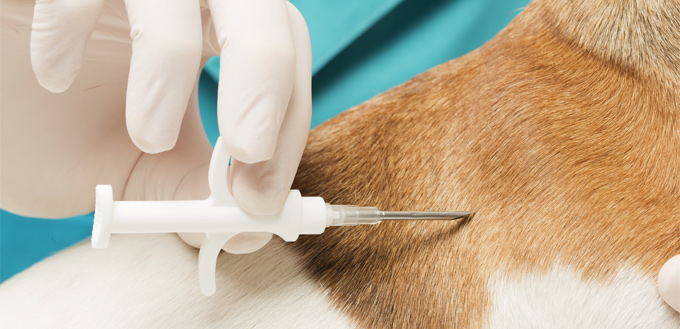According to the American Humane Association, nearly 10 million pets go missing every year. You definitely never want to lose your precious pooch ever, whether by an accident or for a moment of neglect. To ensure that never happens your best precaution would be to microchip your dog. Don’t panic over the microchipping procedure – it’s easier than you think it is! Before jumping into the whole microchipping process, did you know that dogs can be microchipped at a fee of as low as $50?
Here’s all you need to know about microchipping.
What Is Microchipping?
Microchipping is for those who are always worried about their pet’s whereabouts. If you work long hours or have a particularly notorious pupper always looking for adventures, microchipping is your best defense. This is a permanent method in which a chip about the size of a rice grain is implanted under the skin of your dog, between their shoulder blades at the back of their neck. Every microchip contains its own unique number that can be detected with the use of a microchip scanner.

If your furry friend gets lost, animal shelters, vets, and local councils can scan your pet dog to discover the information in the microchip. Therefore, you need to keep the information up to date at all times. Plus, if you transfer your pet to a new owner, ensure that they have the details recorded in the database.
It has been noted that more than six million pets were enrolled in this microchip program and about one million pets returned home because of this service. If you think that this is not a convincing evidence for microchipping your dog, here are 10 more reasons below:
1. Microchipping Does not Cause any Discomfort
If you’re worried that your precious dog would be unnecessarily distressed over microchipping, here’s the good news: it takes only a few seconds to implant the chip. In addition, the procedure is completely safe and simple, without causing any discomfort or distress to your canine. All they would do is flinch a little, but they will be perfectly alright as the pain lasts for a short period of time until they completely forget about it.
2. Microchip will Help you Return your Pet
Pets can go missing in any given situation. They can become displaced if they are scared by fireworks or they might run away if you accidentally leave the side gate open. There’s no particular reason for your canine being displaced, however, it’s obvious that you’ll find them easily if they are microchipped. If any kind soul finds your pet, they’ll take them to the vet or local council and you’ll reunite with your furry friend in no time. Don’t just wait for others, go to the local council and report about your missing dog yourself ASAP.
3. Microchip Protects Against Theft
Sadly, in some parts of the world, sometimes pets get stolen. On top of that, if your pet dog is not microchipped, there is no proof that you’re the owner of the pet in the first place. If your pet went missing and you suspect one particular person has him/her, microchipping will you reveal the true owner of your pooch.
4. Microchip Offers you Peace of Mind
If you’re wondering how a microchip is related to your peace of mind, then here’s the deal. You could let your pet roam around the yard and give them a little space to breathe, you don’t have to worry about your pet being lost forever. Normally, friendly dogs will easily get themselves in the arms of others and since your pet can’t talk, you can have access to the information about where your pet has been all day.
5. Microchips are Safe
Millions of dogs have been implanted with a microchip and there hasn’t been any widespread news of related health issues. They are an inert structure that does not cause any irritation or reaction in your dog, other than the fact that if they are specially designed for medical implants. As per a review by the Veterinary Medicines Directorate in 2014, only eight cases of dogs reacted negatively to the microchip. If dogs are injected with vaccines, there might be a small risk of reaction to the injection process. However, microchips have not shown any such reactions.
6. Microchips are Forever
Once you implant a microchip into your dog’s skin, it will last the duration of his/her life. Meaning, it’s a lifetime fee and you won’t have to renew it on a yearly basis. Of course, dog collars and ID tags are also great but they are not exactly permanent. Suppose if their tag falls off or they break free off their collar, your dog is going to be indistinguishable without the microchip.
7. Microchips are Proof of Ownership
Microchips are proof that your pooch belongs to you and only you. This will prevent other people, who find your dog cute, clean and fluffy wandering around the streets from claiming them as their own. There have been horror stories of people battling to get back their pet, but since their pets were microchipped, it became easier for them to prove that the dog belongs to them.
8. Vacations Become much Easier with a Microchip in your Pet
While travelling with your pet is exciting, your naughty friend might run away or get lost because of the confusing environment for them. If you get your dog microchipped, you’ll be able to find all the available information in a jiffy. This process is very simple. If the microchip manufacturer is a division of The American Animal Hospital Association, your contact information will appear on the computer when the chip is scanned. Don’t worry if it’s not! The manufacturer brand name will show up and the organization will be contacted, from there they’ll be able to fetch your contact information.

9. Microchip is Obligatory in Some States
In many states, microchipping is obligatory for pet dogs. Some states have made it a law for pet owners that their dogs must be microchipped by 12 weeks of age or before giving them away to someone else, depending on whichever ensues first. If you have adopted your pet dog from a reputable pet store or breeder, most likely the dog is already microchipped. But if you fail to have your dog microchipped, you’d be issued with a fixed penalty of $5,500.
10. Microchips are Undoubtedly Reliable
Microchips can last up to 25 years which is way longer than your dog’s average lifespan. The details of your pet’s identifications are stored digitally for which you’ll never have to worry about information being misplaced, lost or destroyed. Unless your dog breaks a world record of replacing their microchip themselves, it is impossible for the information to get out of order.
Benefits of Microchipping Your Dog
Every responsible owner is constantly looking for ways to protect their pet dog from all evil. Microchip is a tried and tested method to keep your canine safe. Here are some more benefits of microchipping your pet dog:
- Saves the life of your pup: When your pup gets lost, he/she can become frightened, causing him/her to dash into unsafe or unfamiliar territories. This is usually when the ID tag falls off in the chaos. Luckily, if a kind soul finds your pup, they’ll bring him/her to a shelter home. The shelter home will then perform a simple scan of the dog’s chip to get the necessary Usually, the information includes the dog’s name, the dog owner’s name, dog owner’s phone number and any other crucial information. Without the microchip, if the ID tag gets lost, it is nearly impossible for rescuers to recognize that the dog belongs to you.
- Microchips are like a key: It’s not a very pleasant thought but in reality, dogs do get snatched off the streets, from outside cafes and stores or even right out of your yard. It’s very easy for a thief to remove the collar but they can rarely remove the microchips. That’s something to be done with the help of a vet. You certainly must have come across news stories about lousy pet abductions and then owners having a hard time proving their ownership. In some areas, the law might not be on your side, so you make sure that you have irrefutable and definite proof in any given situation.
- Fast pet recovery: The first thing that a veterinary clinic or shelter home would do after they find a lost puppy is scan for a microchip. As you know that the microchip is what holds all the information and thus, the original owner can be traced within minutes. Hence, the microchip aids in the fast recovery of pet dogs.
A Study That Supports the Importance of Microchipping
A study conducted by Science Daily reveals that dogs with microchips are 2.5 times more likely to return back to the real owners than the ones without. This study highlights the importance of microchips. Furthermore, microchips have reunited hundreds of pet owners with their lost pets. And for that to happen, you’ll obviously need to record the microchip and keep your contact information updated. Microchips are absolutely safe and reliable with a nationwide registry. Ultimately, it all depends on whether the information that you’ve given are valid.

Microchipping Your Dog FAQ:
Q: What needs to be done in order to maintain the microchip?
A: When your pet is implanted with a microchip, there are three things that need to be done: firstly, ensure that the microchip is registered, ask your vet to scan your pet’s microchip to make sure that it’s functioning and can be detected and finally, keep the registration information updated. If you have moved from one house to another, update the information as soon as you can. That’s all you need to do in order to maintain your pet’s microchip.
Q: How can I update the information in the microchip?
A: If you have to make a change in the microchip, suppose your address or contact number, all you need to do is get in touch with the database that has got your dog’s information. It also depends on which database you had registered your dog with. You might be able to get it done online or over the phone. Usually, there are extra costs associated with altering your details in the microchip in the future. Whatever it takes, it is best if you quickly get the work done.
Q: Will someone be able to track me down through my pet’s microchip?
A: The information that is stored in the microchip is information that you choose to provide. There are protections in places so that a random person cannot get access to an owner’s identification. In fact, there is no way someone can scan and get all the information when they find your pup.
Q: Will a microchip really help me get my pet back if he/she is lost?
A: Absolutely! A study showed that more than 7,700 stray animals at shelter homes showed that microchipped dogs were given back to their owners 52.2% of the time. For the animals that were not returned to their owners reported that the owner’s input incorrect information in the chip or there was no information found in it at all – so, don’t overlook the fact that you need to register the microchip and keep the information up-to-date.
Q: Can I just buy and implant a microchip in my dog by myself?
A: As we have mentioned above, implanting a microchip is a simple procedure, whereby, it’s just like injecting an injection. The answer to this question is yes and no. Although it sounds simple and easy, it is crucial that the implantation of the microchip needs to be done correctly. Placing the needle too deeply, using a little too much of force or placing the microchip in the wrong place cannot just make it difficult to read it, but can also cause life-threatening problems. It must be implanted under the supervision of a vet. That’s because vets exactly know where it needs to be placed and how it should be placed. Not just that, they also know to recognize the signs and symptoms once a problem occurs.
Q: Is it a painful process?
A: The process does include a needle and your pet dog might feel a little uncomfortable just for a few minutes when the microchip is implanted. However, if you’re lucky, your dog won’t even notice it! But if you feel that your canine has a reaction to it, contact your vet right away.
Q: Why are microchips sometimes not detected?
A: As with any other digital stuff, this is also not a foolproof system. It’s quite a rare case for microchips to fail and become incapable of being detected by a scanner. It’s also rare for scanners to be detected with problems, but it can still happen. It could be because of human error such as inappropriate scanning technique or incomplete scanning of the dog, which usually leads to this type of failure. Other failures include dogs that won’t stay still or struggle too much while they are being scanned, tangled hair near the microchip implanted area, excessive fat in that region or a metal collar. Other than these reasons, there are no possible ways that can interfere with the scanning process.
Q: What are some of the problems related to microchips?
A: Some of the very common problems that occur with a microchip are hair loss, swelling, and extremely rare cases include infection and tumour formation. These are reportedly some of the problems that can occur.
Q: Do microchips cause cancer?
A: Reports show that mice and rats developed cancer when they were implanted with microchips. Tumours associated with microchips reported in two dogs, out of which one of them cannot be directly related to the microchip itself. Further investigations show that it may actually have been caused by something else.
Q: Do the benefits outweigh the risks?
A: It definitely does. The shelter homes and veterinary clinics are very well aware of the concerns about an implanted microchip and they do take measures to ensure that a microchip is present in the dog before they let it out for adoption or a decision for euthanizing the dog is made.

Bottom Line
Digital microchips eliminate every possibility of tragic incidents. Whether you just adopted your pup last week or you already have one in your life, the next time you are at the vet, ask them about microchipping. We’re sure your vet will be happy to enlighten you with more information and have all your questions answered. Trust us when we say that if your pet goes missing, you’d definitely be thankful for the microchip.
Have you microchipped your dog? Let us know about your experience in the comments below!
More Pet Product Reviews
Dog Motorcycle Helmets
Dog ID Tags
Leather Dog Collars
Dog Hair Bows
Dog Lift Harnesses
Dog Cones
Herding Ball for Dogs
Toys for Blind Dogs
Dog LED Collars
Dog Cooling Vests






